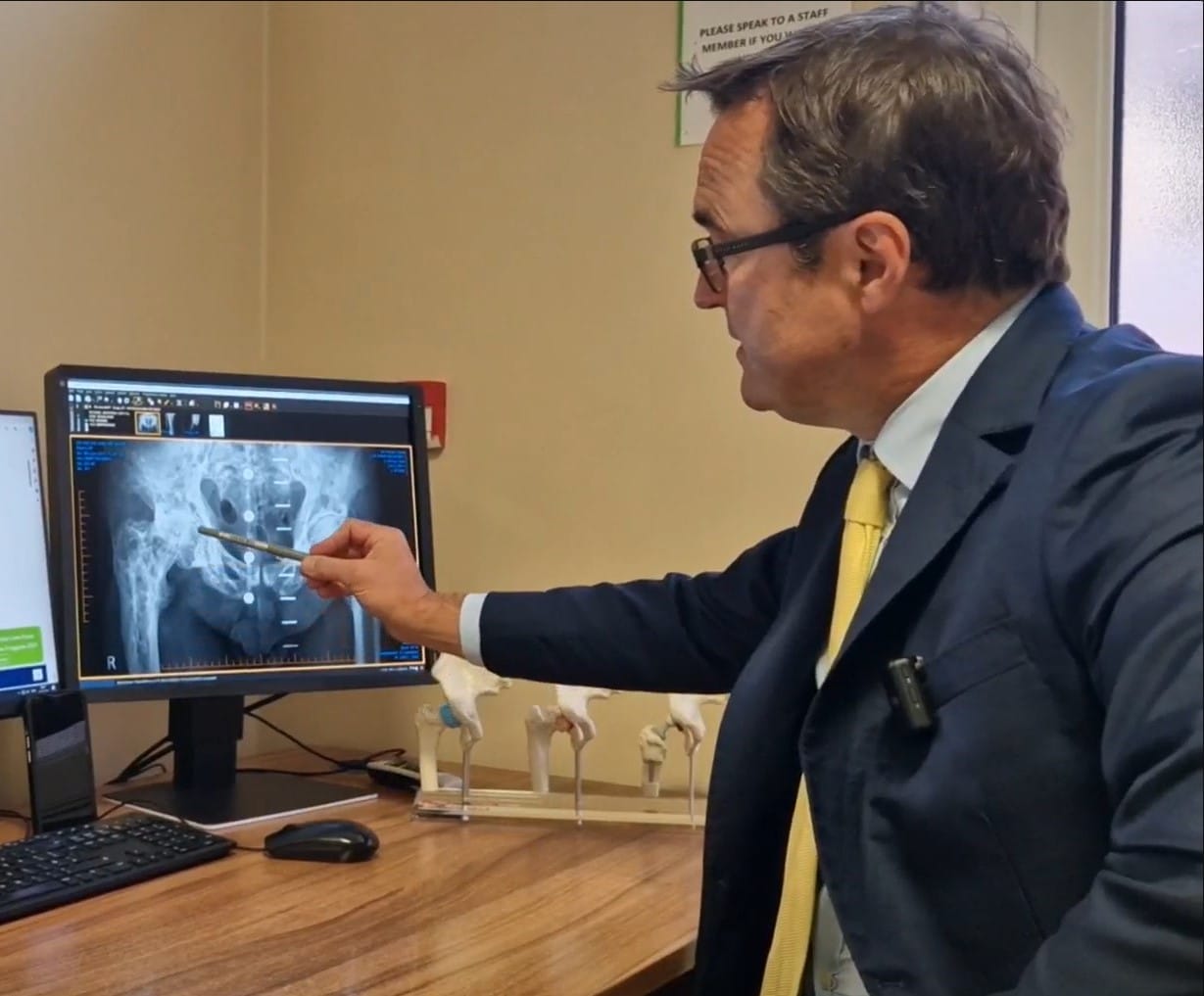Hip replacements can be a vital surgery for many people, reducing pain and enhancing their quality of life. However, you may be worried about the procedure and unsure how it is done.
What is a hip replacement?
Hip replacement surgery, also called hip arthroplasty, is when damaged sections of the hip joint are removed and replaced with a metal, ceramic, or plastic artificial joint. The new artificial hip should help alleviate any pain that you were experiencing before and enable you to move much more freely.
A hip replacement may be suggested to help with conditions such as osteoarthritis, rheumatoid arthritis, and osteonecrosis. These conditions can cause problems with the hip joint, leading to chronic pain, stiffness and reduced mobility.
A modern hip replacement is designed to last for at least 15 years, but some people find that theirs lasts much longer without the need for further treatment. The durability of your new hip joint will depend on factors like your age, your overall health, how active you are post-surgery and the type of materials used in the artificial implant.
Hip replacement surgery usually takes an hour to 90 minutes to be completed.
Is a hip replacement major surgery?
Hip replacement is major surgery, so it is only recommended if other non-operative treatment options, such as physiotherapy or steroid injections, haven’t been effective in relieving hip pain and stiffness.
There are also some contraindications that can prevent you from getting hip replacement surgery. These can include:
- Pre-existing infections
- Severe osteoporosis
- Unable to follow pre and post-surgery instructions
- Heavy smokers – they have a higher risk of needing follow-up surgery than non-smokers
Your doctor will advise you if you have any of these contraindications before putting you forward for surgery.
How do you know if you need a hip replacement?
Hip replacement surgery will be recommended to you if one or both of your hip joints are damaged and no other treatment is working.
A hip replacement may be recommended if you:
- Have severe, persistent pain in your hip
- Have decreased mobility and a low range of motion that affects your ability to carry out everyday tasks such as walking or getting dressed
- Aren’t able to sleep well due to pain and discomfort
- Find that your hip pain is affecting your quality of life
Most people will be able to have hip replacement surgery, and those with hip joint problems will find that it can transform their daily life.
How is hip replacement surgery performed?
Hip surgery can be performed in two different ways — either traditionally or minimally invasive.
Traditional hip replacement
A traditional hip replacement involves one large incision being made on the side or back of the hip. The surgeon will need to cut through muscles and tendons to get to the joint — which means that recovery after traditional hip replacement surgery can take time.
During the procedure, the upper part of the thigh bone (femur) is removed and the head of the femur is hollowed out to allow for the artificial joint (made up of a ball and socket) to be fitted into place. The new joint is then fixed with acrylic cement — a type of paste that will bond it directly to the bone and hold it in place.
Hip replacement surgery is usually done either under general anaesthetic (so you’ll be asleep during the procedure) or under spinal anaesthetic (which means you will be awake during surgery, but will have no feeling from the waist down).
Most people will be recommended to have a traditional hip replacement, as it’s the most common procedure.
Minimally invasive hip replacement
With a minimally invasive hip replacement, the surgeon will make fewer cuts to the tissue around the hip and will make much smaller incisions. The implants used will be the same as the ones in a traditional replacement.
Specially designed surgical instruments are needed to prepare the socket and femur, which is why it’s not the first go-to option for some hospitals.
Minimally invasive hip replacement vs traditional hip replacement
There are some key differences between the two types of hip replacement surgery, but they can both have their own benefits.
The main difference between the two is that minimally invasive surgery requires fewer, smaller incisions, and a traditional replacement will need a large 30cm incision to access the hip.
Minimally invasive hip surgery isn’t suitable for everyone, and your doctor will carry out a thorough health check before putting you forward for it. Typically, patients that are recommended for this type of hip replacement are younger and of a healthy weight.
Minimally invasive hip replacement won’t be suitable or recommended to high-risk patients. This can include people who are:
- Overweight
- Had previous hip surgeries
- Have problems with slow wound healing
For traditional hip replacement surgery, the patient just needs to be healthy enough to withstand and recover from major surgery.
Minimally invasive hip replacement pros and cons
There are a number of advantages to having a minimally invasive hip replacement. For example, you’ll be left with a smaller scar, less damage to the surrounding tissue, and a quicker recovery.
There are some disadvantages though. The procedure is more challenging for the surgeon as they have limited access, the skin or tissue can be overstretched and there is an increased risk of nerve damage.
However, despite these risks, this type of surgery tends to have extremely positive outcomes.
Traditional hip replacement pros and cons
A traditional hip replacement is probably the type of surgery that most people expect when needing their hip replaced.
Advantages of this method include the surgeon who carries out the procedure having a clear view of the hip joint and using tried and tested techniques. Because of these factors, the risk of post-surgical complications may be lower.
There are a few possible disadvantages to consider though. These can include more damage to the muscles and tissue around the hip, a larger incision and scar, and a slower recovery time.
However, traditional hip replacement surgery has been used for many years, and it is a very successful procedure.
Are there alternatives to hip replacement surgery?
Hip replacement surgery is never mandatory, and you can decide if it’s best for your body. There are some alternatives out there that can be considered instead of major surgery, and they can prove to be quite successful.
Non-surgical alternatives
Physiotherapy and steroid injections are some of the most common non-surgical treatment options for hip pain. You may be prescribed pain relief by your doctor that is stronger than over-the-counter medication as well.
If these don’t work, hip replacement surgery or a different surgical alternative may be suggested.
Surgical alternatives
Hip resurfacing involves a small implant being fitted into the joint, and only a small amount of the bone is removed. However, this surgery has become less common due to possible complications — leaving patients and doctors wary.
You can also have a partial hip replacement, which is where only the ball of the hip joint is replaced. This can be a great treatment option for those who only have issues with the ball of their hip. But a lot of the time, most people’s hips will be damaged in the socket as well — meaning they have to have a total hip replacement.
Hip fusion is another alternative to replacement surgery. This procedure involves the femur and pelvis being fused together by a metal plate and screws. It is usually recommended to those who do heavy-duty labour, as a normal hip replacement would wear away fairly quickly. In the long run, they may need to have a hip replacement as hip fusion can limit mobility over time.
Speak to our hip surgery experts
When it comes to minimally invasive hip replacement vs traditional hip replacement surgery, both procedures can be effective and have their benefits.
If you’re experiencing hip pain or stiffness in the joint, get in touch with our team of experts at Horder Centre. We’ll be able to discuss treatment options with you and help you plan your next steps.
What makes Horder Healthcare unique
Horder Healthcare is committed to providing the very best quality of care for our patients and customers. We are continuously working on improving and reducing risks and this is reflected in our consistently high CQC results, patient satisfaction questionnaires and minimal levels of infection.
We are a charity
We reinvest our profit to benefit more people and help us achieve our aim of advancing health.






